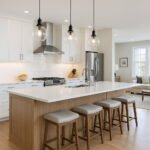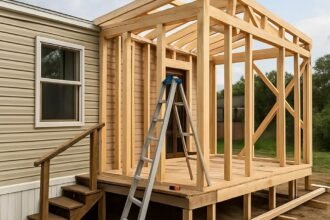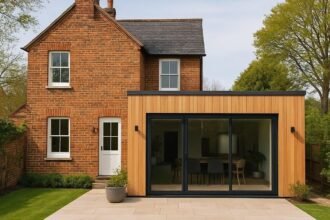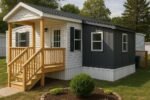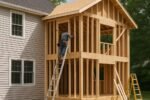When considering a home addition, it’s essential to understand the factors that influence costs. Your choices in type, size, and location play significant roles in determining your budget. Room additions, kitchen expansions, and bathroom remodels each come with their own price ranges. However, the final cost can vary due to design complexities and labor expenses. Are you prepared for the potential surprises that could arise during the process?
Key Takeaways
- Room additions typically range from $20,000 to $50,000, while kitchen expansions cost between $15,000 and $30,000.
- Bathroom remodels usually fall between $10,000 and $25,000, and sunroom additions cost around $15,000 to $40,000.
- Costs are influenced by design complexity, location, size, material quality, and labor rates.
- Set aside 10-20% of your total budget for unexpected expenses during the construction process.
- Multiple contractor quotes can help determine the most accurate and competitive pricing for your project.
Understanding Different Types of Home Additions
When you’re considering a home addition, it’s essential to understand the various types available, as each can considerably impact your living space and budget.
Sunroom additions offer a bright, airy space for relaxation or entertaining, typically constructed with large windows to maximize natural light. They can enhance your home’s aesthetic appeal and provide an enjoyable environment year-round.
On the other hand, basement conversions transform underutilized areas into functional spaces, such as guest rooms or home offices. This option often maximizes existing square footage while adding value to your property, making it a practical choice for expanding your living area.
Factors Influencing Home Addition Costs
While planning a home addition, several factors can considerably influence the overall cost. Key elements include design considerations, such as architectural style and materials used, and location impact, which may vary based on local building codes and labor costs.
| Factor | Description | Cost Impact |
|---|---|---|
| Design Considerations | Complexity and materials chosen | High/Medium/Low |
| Location Impact | Local regulations and labor costs | High/Medium/Low |
| Size of Addition | Total square footage added | High/Medium/Low |
Understanding these factors helps you budget effectively for your home addition.
Average Costs of Common Home Additions
When considering home additions, understanding the average costs for specific projects is essential.
Room additions typically range from $20,000 to $50,000, while kitchen expansions can set you back between $15,000 and $30,000.
Bathroom remodels often fall between $10,000 and $25,000, depending on the scope of work and materials used.
Room Additions Pricing
Although adding a room can enhance your home’s functionality and value, understanding the costs involved is essential for effective budgeting.
Room additions vary widely in price, influenced by design considerations and space optimization. Here are some average costs to keep in mind:
- Bedroom Addition: $15,000 – $40,000
- Bathroom Addition: $10,000 – $30,000
- Living Room Addition: $20,000 – $50,000
- Sunroom Addition: $15,000 – $40,000
These figures can fluctuate based on materials, labor, and your location, so it’s wise to obtain multiple quotes to find the best deal.
Kitchen Expansion Expenses
Many homeowners find that expanding their kitchen not only improves functionality but also enhances the overall appeal of their home. When considering kitchen expansion expenses, it’s important to factor in kitchen design and appliance upgrades. Here’s a breakdown of average costs:
| Item | Average Cost | Notes |
|---|---|---|
| Kitchen Design | $5,000 – $15,000 | Custom layouts increase costs |
| Appliance Upgrades | $3,000 – $10,000 | High-efficiency models preferred |
| Labor Costs | $50 – $150/hour | Varies by contractor and location |
These investments can greatly elevate your home’s value and livability.
Bathroom Remodel Costs
A bathroom remodel can greatly enhance your home’s comfort and resale value, with costs typically ranging between $5,000 and $25,000, depending on the scope of the project.
Key factors influencing your budget include:
- Quality of bathroom fixtures
- Complexity of plumbing and electrical work
- Tile and flooring selections
- Renovation timelines and labor costs
To get the best return on investment, consider prioritizing durable materials and efficient layouts.
Planning ahead can help you navigate potential delays and keep your project on track, ensuring your dream bathroom becomes a reality without unnecessary financial strain.
Budgeting for Materials and Labor
When planning a home addition, understanding the costs associated with materials and labor is vital to staying within budget.
Start by determining the material quality you desire; higher-quality materials typically come with increased costs but can enhance durability and aesthetics.
Next, assess labor costs, which can vary based on your location and the complexity of the project. Get multiple quotes from contractors to guarantee you’re making an informed decision.
It’s essential to allocate funds not just for materials and labor but also for unexpected expenses that may arise during the construction process to avoid financial strain.
The Role of Permits and Regulations
Before you break ground on your home addition, securing the necessary permits and adhering to local regulations is key to a smooth construction process.
Understanding permit acquisition and ensuring regulatory compliance can save you time and money.
- Research local codes before starting
- Consult with professionals about required permits
- Submit plans for approval to avoid delays
- Keep records of all permits and inspections
Unexpected Expenses to Consider
Though you might’ve a budget in mind for your home addition, unexpected expenses can quickly arise and derail your plans.
Hidden costs often lurk beneath the surface, such as structural repairs, outdated wiring, or plumbing issues that may not be visible until work begins.
Additionally, renovation surprises like labor rate changes or higher than anticipated material costs can inflate your budget considerably.
It’s essential to set aside a contingency fund of at least 10-20% of your total budget to accommodate these potential pitfalls.
Being prepared for these expenses will help guarantee your project stays on track and within reasonable limits.
Financing Options for Home Additions
As you plan your home addition, exploring financing options is essential to guarantee your project remains financially viable.
Here are some options to evaluate:
- Home Equity Loans: Tap into your home’s equity for a lump sum.
- Home Equity Line of Credit (HELOC): Access funds as needed, based on your home’s value.
- Renovation Loans: These loans cater specifically to improvement projects, often including costs in your mortgage.
- Personal Loans: Unsecured loans can provide quick funding without tying to your property.
DIY vs. Hiring a Contractor
Deciding whether to tackle your home addition as a DIY project or hire a contractor can greatly impact both your budget and the final outcome.
DIY pros include lower costs and design flexibility, but be wary of skill requirements and stress factors.
On the other hand, contractor benefits such as quality assurance, efficient project timelines, and warranty considerations often justify the higher expense.
A cost comparison reveals that while DIY may save money upfront, future maintenance and potential mistakes can add up.
Ultimately, weigh your capabilities against the assurance of a professional finish when making your choice.
Maximizing Your Return on Investment
To maximize your return on investment for a home addition, start by evaluating how much value the project will add to your property.
Focus on features that have high impact, such as modern kitchens or energy-efficient upgrades, as these tend to attract buyers.
Additionally, consider budgeting for future trends to guarantee your investment remains relevant in the evolving market.
Assessing Property Value Increase
When considering a home addition, understanding how it impacts your property value is essential for maximizing your return on investment. A well-planned addition can greatly enhance your home’s appeal and market value.
Keep these factors in mind:
- Conduct a property appraisal before and after the addition.
- Research current market trends to identify desirable features.
- Assess potential increases in your neighborhood’s property values.
- Consider the addition’s alignment with local buyer preferences.
Choosing High-Impact Features
Although you might have a vision for your home addition, selecting high-impact features can greatly influence your return on investment. Prioritizing high-impact materials and stylish features not only enhances aesthetics but also boosts property value.
| Feature Type | High-Impact Materials | Stylish Features |
|---|---|---|
| Flooring | Hardwood, Tile | Open Concept Layout |
| Kitchen Upgrades | Quartz Countertops | Modern Appliances |
| Outdoor Spaces | Composite Decking | Built-in Fire Pits |
| Energy Efficiency | Energy Star Windows | Smart Home Technology |
Choosing wisely here can yield significant financial benefits.
Budgeting for Future Trends
As you plan your home addition, understanding future trends is essential for maximizing your return on investment.
Consider these key aspects:
- Incorporate future design elements to attract buyers.
- Use sustainable materials that enhance energy efficiency.
- Design for adaptability to accommodate changing family needs.
- Focus on outdoor living spaces to boost appeal.
Tips for Planning Your Home Addition Budget
Planning your home addition budget requires careful consideration since unexpected expenses can quickly derail your project. Start with a detailed cost estimation that includes materials, labor, permits, and contingencies. Research local rates to guarantee accuracy.
Next, establish a realistic project timeline, accounting for potential delays, which often arise from permitting processes or unforeseen issues. Prioritize your must-haves versus nice-to-haves to maintain flexibility in your budget.
Regularly review expenses against your estimates to stay on track. Finally, consider consulting professionals for expert insights, helping you avoid costly mistakes and guaranteeing your addition meets both your vision and financial constraints.
Conclusion
In summary, understanding the costs and factors associated with home additions is essential for effective budgeting. By evaluating your needs, researching average costs, and considering design complexities, you can create a realistic financial plan. Don’t forget to factor in permits and potential financing options, as well as the choice between DIY and hiring a contractor. With careful planning and a well-structured budget, you can enhance your home while maximizing your return on investment.

